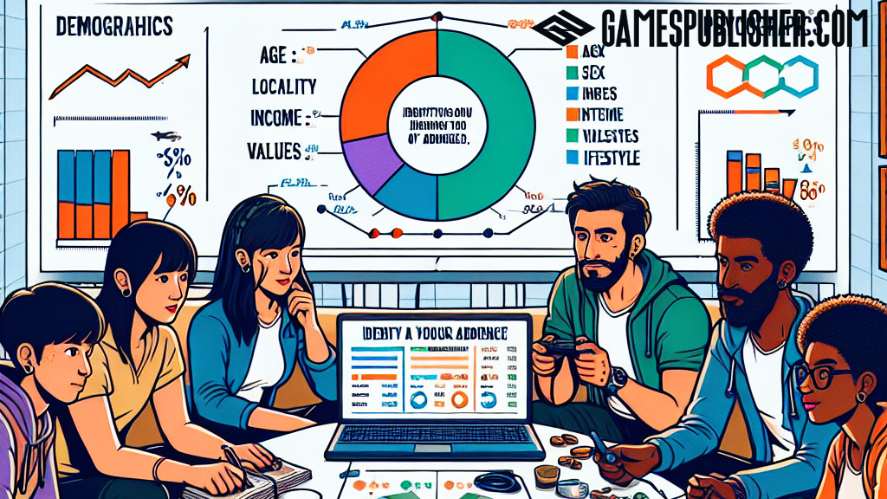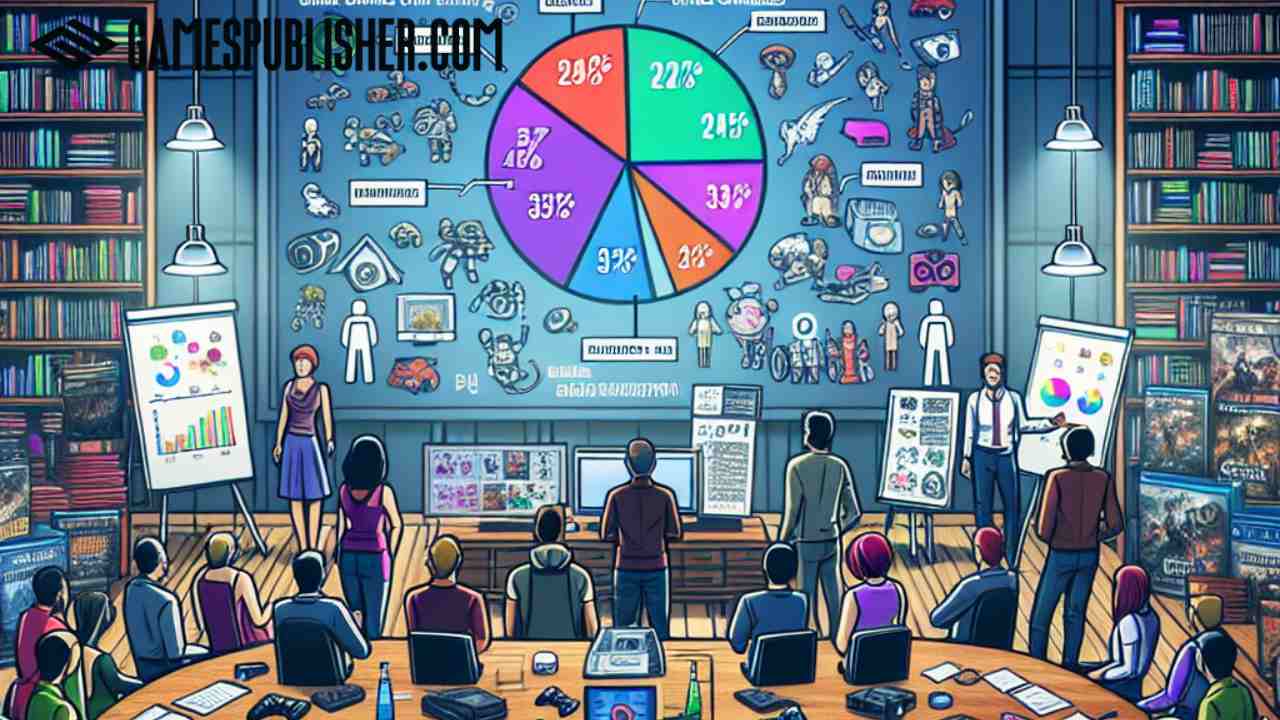Identifying your game audience is very important.
It can help you make the right decisions, and changes can be brought into the different processes dealing with the development and marketing of the game.
In this article, let’s discover why identifying a game’s target audience is a turnaround approach for game development and publishing.
Understanding Your Game’s Genre and Niche
All the games on the market fall into a particular category.
Category and niche are essential when categorizing your game so that you can be in a position to attract the right players and have the marketing messages to get to them.
Identifying Your Game’s Unique Selling Points (USPs)
What distinguishes your game from other games in the game target market?
Is it the graphics, image, plot, more engaging gameplay, or maybe all of the mentioned and still more?
Identify elements that make your game special offer – the features of your product that tell it apart from similar games.

Some ways to discover your USPs are surveys, polls on the polling site, and other sites to survey your gaming target market base.
Ideally, their perceptions can be constructive in establishing what carries value to them.
Analyzing Competitor Games
Thoroughly researching competitor games in your genre is a strategic move. Therefore, analyzing your competitor games within your targeted category is recommended.
Determine the age, gender, interests, and trends of its game target audience. Analyze marketing approaches and how they engage their communities.
On the same note, competitor analysis can help discover areas your competitor is not exploiting or groups of people not served by the competing game.
Defining Your Target Audience
Understanding your game target audience goes beyond knowing their age or location. It’s about delving into their interests, behaviors, and motivations.
This knowledge is the cornerstone of effective game development and marketing.
Demographics and Psychographics
Identifying your gamer’s audience is a complex procedure involving clients’ demographic characteristics and psychographics.
Demographics relate to the general features of the targeted.
For example, age, sex, locality, income, etc,… These factors give a general view of your prospective players, and it will help ascertain their profile.

However, to truly resonate with your players, you must move beyond the demographics and determine their psychographics.
Psychographics, including interests, values, lifestyle, etc., target the psychological characteristics of your game target audience.
If you know what encourages your players and the kind of games and styles they prefer, you will address their interests and focus your advertisements games on what matters to them most.
Thus, using demographics and psychographics facilitates the development of a complete picture of the target audience.
The holistic approach empowers you to generate specific marketing strategies that will fit the needs and expectations of the players.
Creating Player Personas
Player personas are your ideal players’ representations.
They are based on actual audience data and help you visualize your game target audience as individuals.
A player persona might include details like:
- Name and Age: Give your persona a name and age to make them more relatable.
- Background: Describe their lifestyle, occupation, and interests.
- Motivations: What drives them to play games?
- Pain Points: What challenges do they face when playing games?
- Gaming Preferences: What genres do they enjoy?
Creating detailed player personas will allow developers to focus their game and promotion strategies on specific parts of the audience.
This makes sure your game will not only appeal to the right audience but also entertain their desires.
Using Polls and Surveys to Gather Audience Insights
Questionnaires are critical in survey research since they allow direct gathering of players’ preferences, opinions, and interests.
So, constructed questions and efficient analysis of players’ answers will help you make efficient decisions influencing your game development and marketing strategies.
Designing Effective Surveys
Before creating effective survey questions, consider carefully the various factors below:
- Clear Objectives: Define the specific information you want to gather. Are you interested in learning about their favorite game genres, preferred platforms, or spending habits?
- Concise Questions: Keep questions short, focused, and easy to understand. Avoid jargon or technical terms that might confuse respondents.
- Multiple Choice & Open-Ended Questions: Employ a variety of question types to collect quantitative and qualitative data from your audience.
- Incentivize Participation: Offer rewards or incentives to encourage people to complete your survey.
- Polling.com: Consider using polling platforms that offer user-friendly tools for creating, distributing, and analyzing surveys.
Although surveys benefit marketing research, a poorly constructed survey can tell little about your gaming target market.
Analyzing Survey Data
Once the survey is conducted and the responses are collected, it is time to determine what can be gleaned from the results.
Look for trends and patterns and identify correlations.

Determine your players’ preferences, difficulties, etc… Then, refine your game, marketing strategy, and overall strategy for your game.
Audience data is only valuable when you know how to exploit and analyze it to get an overview of the situation after the survey.
Engaging with Survey Participants
When collecting survey feedback, show participants their valuable and vital opinions and contributions.
You can create a community forum or social media group to take the conversation and gather ongoing feedback anytime.
By creating polls and using different types of surveys, your community, where people eagerly await the release of your game and will undoubtedly play it.
This engagement could be an excellent strategy for creating hype for your game.
Leveraging Social Media and Community Platforms
Social media and online communities should be considered effective means for game developers and video game publishers to spread the information to their players.
This is also one factor that can affect your game’s success.
Building an Online Presence
Establishing a solid online presence is essential for reaching and engaging your target audience.

To achieve this, consider the following strategies:
- Choose the Right Platforms: Identify and focus on the social media platforms where your game target audience is most active to maximize engagement.
- Create Engaging Content: Share updates, behind-the-scenes glimpses, concept art, and other content that interest your audience.
- Interact with Your Community: Engage with your audience by responding to comments, answering questions, and participating in discussions to show you value their input.
- Run Contests and Giveaways: Organize engaging activities to build excitement and attract new followers.
A well-crafted online presence can get recognition, attract more people to play the game, and create a community for your game.
Joining and Creating Communities
The strategy of joining existing communities and building your own is a highly effective way of ensuring you have loyal players and an opportunity to receive constructive.
You can engage and contribute to the gaming forums and relevant social groups where your game target player is actively involved.
This means ideas, questions, and opportunities to build a good relationship with them are always around.
At the same time, the development of a separate forum or page in the social network for the game contributes to the strengthening of the players’ community and the open discussion of opinions regarding the game.
Besides, it offers the advantage of a heavy flow of traffic, a high level of interest, and numerous feedback sources that can be highly beneficial for developing a faithful audience eagerly waiting for your game.
Finally, by developing the communities mentioned above, you will have a group of players passionate about supporting a game and contributing to its growth and victory.
Beta Testing and Feedback Loops
Beta testing is critical in developing the game as it allows real users to see the product and make any necessary changes.
It is an opportunity to be sure about the quality of your game and to create work that would be worth the interest of your target players.
Recruiting Beta Testers
Recruiting a diverse group of testers representing your target audience is essential to ensure a successful beta test.

Here are a few tips for finding and attracting the right beta testers:
- Define Your Criteria: Clearly outline the characteristics you’re looking for in beta testers, such as demographics, gaming preferences, and experience levels.
- Use Multiple Channels: Reach out to potential testers through social media, online forums, gaming communities, and even dedicated beta testing platforms.
- Offer Incentives: Provide exclusive rewards or early access to the game to motivate players to participate in your beta test.
- Screen Applicants: Review applications carefully to ensure you select testers who align with your game target audience profile.
However, the goal is to have as many testers as possible with different opinions that can refine the game and make it enjoyable for the player.
Incorporating Feedback
Once your beta test is underway, it’s crucial to effectively gather, analyze, and implement feedback from your testers.
This is how to make the most of this valuable information:
- Collect and Organize Feedback: Create a centralized system for collecting feedback, such as surveys, bug reports, or online forums.
- Prioritize Issues: Identify the most critical issues and areas for improvement based on tester feedback.
- Implement Changes: Make necessary adjustments to the game based on feedback, but be mindful of maintaining the core vision of your game.
- Communicate with Testers: Keep testers informed about your changes based on their feedback.
Actively incorporating beta testers’ feedback helps fine-tune your game, meet audience expectations, and boost its quality and success at launch.
Adjusting Marketing Strategies Based on Audience Feedback
Marketing your game effectively requires a dynamic approach that adapts to the preferences and behaviors of your target audience.
Collecting and evaluating feedback can help you enhance your strategies to increase reach and engagement.
Adapting Marketing Campaigns
To successfully adapt your marketing campaigns for optimal effectiveness, consider the following key steps:
- Identify Key Insights: Review feedback from surveys, polls, social media interactions, and beta testing to understand what resonates with your audience.
- Refine Messaging: Customize your marketing messages to emphasize the features of your game that resonate most with your target audience.
- Adjust Channels: Allocate your marketing budget to the platforms and channels where your audience is most active.
- Experiment and Iterate: Test different marketing approaches, measure their effectiveness, and refine strategies based on the results.

Always focus on the player’s responsiveness, and you may guarantee the continuous efficiency of the marketing campaigns.
Measuring Marketing Effectiveness
Tracking the performance of your marketing efforts is crucial for understanding what works and what doesn’t.
Use tools and metrics to evaluate your success:
- Website Analytics: Monitor website traffic, bounce rates, and conversion rates to assess the effectiveness of your online presence.
- Social Media Analytics: Track engagement metrics like likes, shares, comments, and follower growth to gauge the success of your social media campaigns.
- Email Marketing Metrics: Assess the success of your email marketing by tracking open rates, click-through rates, and conversion rates.
- Surveys and Polls: Gather feedback directly from your audience to assess their awareness, interest, and perception of your game.
If you monitor and evaluate these parameters frequently, you can identify areas for improvement and optimize your marketing strategies for maximum performance.
Conclusion
The process of adapting marketing campaigns is a process that requires ongoing analysis of players’ feedback and a willingness to experiment and adjust strategies accordingly.
Game developers and game publishers need to focus on the players and pay attention to the trends out there to ensure that the marketing strategies will come to the production of great campaigns.
Let’s practice right after you finish reading this article! If you want further advice and support, let’s go to Gamespublisher.com. We have all the sources of information on all aspects of game marketing.
Loading survey...

